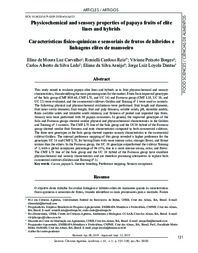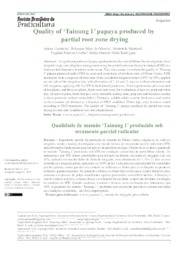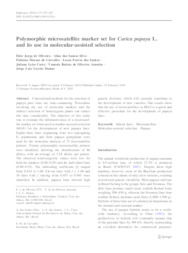 Busca de Publicações
Busca de Publicações
Physicochemical and sensory properties of papaya fruits of elite lines and hybrids.
Author(s): CARVALHO, E. de M. L.; REIS, R. C.; BORGES, V. P.; LEDO, C. A. da S.; ARAÚJO, E. da S.; DANTAS, J. L. L.
Summary: This study aimed to evaluate papaya elite lines and hybrids as to fruit physicochemical and sensory characteristics, thus identifying the most promising ones for the market. Fruits from improved genotypes of the Solo group (CMF H10.60, CMF L78, and UC 14) and Formosa group (CMF L10, UC 10, and UC 12) were evaluated, and the commercial cultivars Golden and Tainung nº 1 were used as controls. The following physical and physicochemical evaluations were performed: fruit length and diameter, fruit inner cavity diameter, fruit weight, fruit and pulp firmness, soluble solids, pH, titratable acidity, Ratio (soluble solids and titratable acidit relation), and firmness of peeled and unpeeled ripe fruits. Sensory tests were performed with 50 papaya consumers. In general, the improved genotypes of the Solo and Formosa groups showed similar physical and physicochemical characteristics to the Golden and Tainung n° 1 controls. The CMF L78 line of the Solo group and the UC10 hybrid of the Formosa group showed similar fruit firmness and ratio characteristics compared to both commercial cultivars. The three new genotypes in the Solo group showed superior sensory characteristics to the commercial cultivar Golden. The internal preference mapping of this group revealed a higher preference for the genotypes UC 14 and CMF L78, for having fruits with more intense color, stronger flavor, and firmer texture than the others. In the Formosa group, the UC 10 genotype outperformed the cultivar Tainung nº 1, with a global acceptance percentage of 96.15%, due to a more intense aroma, color, and flavor. The CMF L78 line of the Solo group and the UC 10 hybrid of the Formosa group have excellent physicochemical and sensory characteristics and are therefore promising alternatives to replace both commercial cultivars (Golden and Tainung nº 1).
Publication year: 2020
Types of publication: Journal article
Unit: Embrapa Cassava & Fruits
Keywords: Mamão, Melhoramento Vegetal, Pseudomonas Carica Papayae



